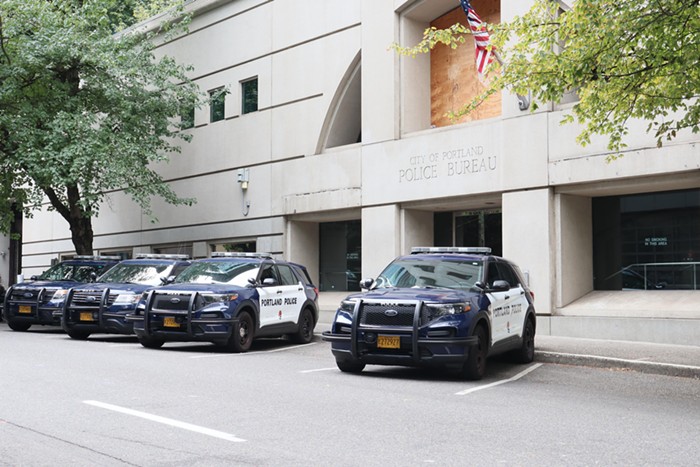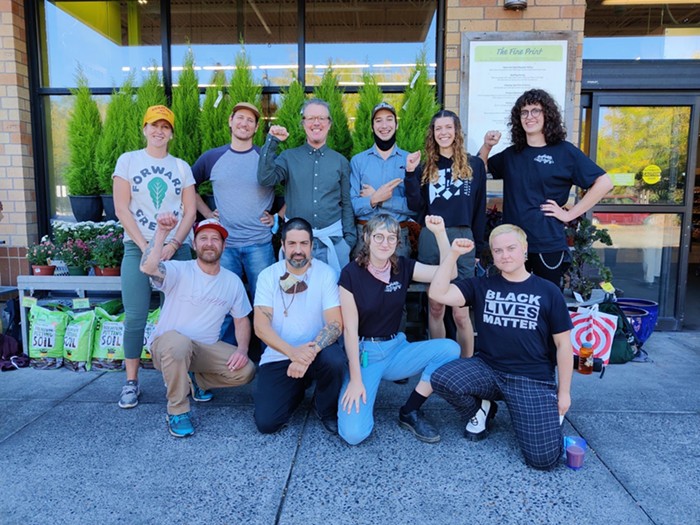Twelve years ago, a woman named Tenea Storm decided she would convert her mother's Sellwood home into a magical candy palace and bakery. And, by God, she did it. Though generally cars rush past the strange house on SE Milwaukie, some slow to stare at the wooden lollipops and candy canes covering the house's walls and white picket fence. The home's windows are lined with cement chocolate-chip cookies nestled among frosting-like peaks of industrial spackle. Hand-painted jellybeans coat the well-worn concrete pathway to the home's front door.
"I wanted to build a place where people could dream," says Storm, sitting at a card table underneath a fake tree built into the corner of what was once a dining room. Along with young recruits from the neighborhood and a tight-knit group of friends, Storm has meticulously transformed every room of her family's home into a playful, detailed little fantasy world. This room, with two fake trees branching across the ceiling and paintings of princesses on the walls, is the Fairy Forest. Down the hall, lush fake pies hang from the ceiling above glass cases full of real pastries for sale. Unicorns are everywhere. Storm has some explaining to do.
Running the Candyland and bakery is Storm's full time job—she says the bakery usually does good business, shipping sugar free and gluten free cookies nationwide. Right now, six days before Christmas, she seems a little sad. Business has been very slow since the snowstorm but, worse than that, people have been canceling their Santa visits. Usually this time of year, the house is full of big groups of kids coming through to sit with Santa—a very accommodating volunteer in a fat suit—but this year, Storm sighs, some kids will miss out. Storm is a 37-year-old mother and is dressed in work clothes with a bandana tied over her reddish-brown hair. No matter what she's talking about—whether it's fairies, profit margins, or distributing toys to poor kids—her voice is straightforward, moderate, and surprisingly sane. She grew up in this house, upstairs in a room where she now plans to install a talking pegasus. Big ovens have always filled the downstairs, where her grandmother and then her mother ran a catering business.
The origins of Candyland are, of course, bizarre. Fifteen years ago, Storm, her fiancé Tim Hawley, and their five-week-old baby Keana were leaving a movie at Lloyd Center—arguably the most mild-mannered, most uncandyland place in Portland—when they were suddenly surrounded by a mob of 100 angry teenagers. The teens had been turned away from a Benson High School dance and one of them allegedly shouted, "Get the white boy!" before the group kicked Hawley 72 times in the head and chest and threw him down a flight of stairs.
The story was all over the news for months. When it died down, Storm had an $80,000 settlement, and a seriously brain-damaged husband. He became abusive. She had a baby to care for. And so Storm worked nights as a room service server in a big hotel. It was there, feeling miserable in the hotel's kitchen one night, that Storm had the epiphany. Candyland.
"I got the idea at three o'clock in the morning to make this gingerbread house that would be a haven for kids like me," she says. "I wanted to give something back to Keana that I felt we had both lost. I began asking customers what they thought represented childhood innocence. What makes you feel safe? What makes you feel at home? It always came back to a gingerbread house."
At first, Storm tried to create the dream house through bureaucratic channels. She made a business name—Keana's Candyland—and filed the paperwork to establish a nonprofit, too. She contacted the Small Business Administration and says she tried to get support from the city. But it was complicated... everything kept falling through. Finally, Storm decided to build the candy home on her own, with money from the settlement.
"When I first tried to paint, I was eight months pregnant. I was awful," recalls Storm. She and a friend bought a bucket of paint, put on overalls, and one day launched into turning the upstairs bathroom into an undersea world. It was tough, with zero construction experience. "I knew cooking, I knew cake decorating," she says. Today, Storm's strange cake maker carpentry is visible around the house. Cookies are adhered to the stairway with what looks like spackle, but on closer inspection turns out to be Perma-Ice, a plastic "frosting" used on fake cakes.
In 1997, Storm began recruiting students from the after-school home economics class she taught at Sellwood Middle School. The dozen or so kids loved painting walls and putting fake pies together. The project spiraled and spiraled until now every room is stuffed with color. "There are thousands of hours in these walls," says Storm, pointing out that she's only slightly improved as an artist.
These days, all kinds of people are drawn to the candy house.
"Boy Scouts, church groups, fairy guilds, medieval guilds, the chipmunk association, lots of Japanese tourists," says Storm, listing off some her regular visitors. "We get weird people. Some people who have Hansel and Gretel phobia... I had one person come in and tell me she was the queen of the elves, okay?"
Candyland is never complete. As she admires the intricately painted walls of the Fairy Forest, Storm mentions that someday the room will have a talking tree, fairy ballroom, "thunderscape," and working waterfall. This is part of a grand plan (involving "several teams of animators") to redesign the quaint little house. In addition to water features in every room, there will be a 35-foot-tall pirate ship in the frontyard.
"There's going to be a balcony across the back of the house with a licorice whip slide that goes into a meringue pie," Storm explains, completely serious. It's easy to doubt her, but this is a woman who almost single-handedly converted her entire house into Candyland while raising four children.
No timeline for the project is set, but Storm estimates the big multi-phase renovation will cost about $7.9 million. It will also create 33 new jobs, many of those being the cast of pirates for the ship.
"Some of the stuff we've done sounds crazy," admits Storm. "But... we're not doing it to make any reasonable sense."



















